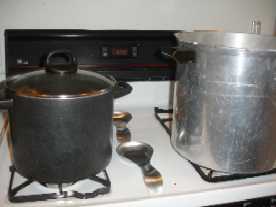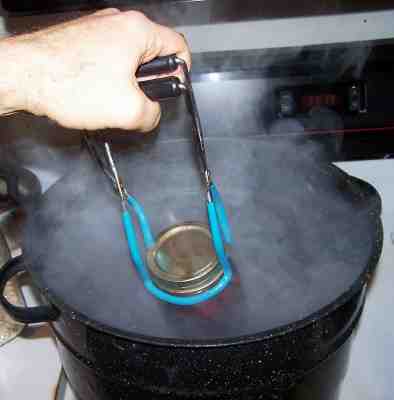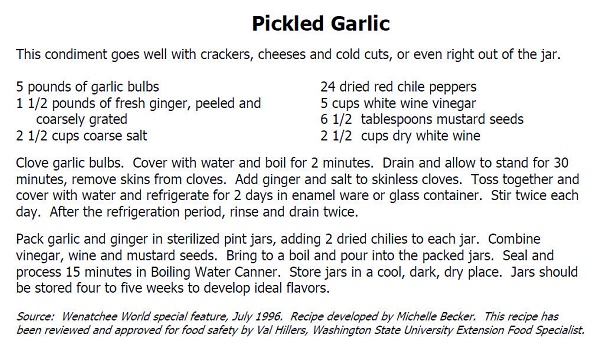
Looking for How to can your own homemade canned pickled garlic (complete directions with photos) in 2025? Scroll down this page and follow the links. And if you bring home some fruit or vegetables and want to can, freeze, make jam, salsa or pickles, see this page for simple, reliable, illustrated canning, freezing or preserving directions. There are plenty of other related resources, click on the resources dropdown above. If you are having a hard time finding canning lids, I've used these, and they're a great price & ship in 2 days.
If you have questions or feedback, please let me know! There are affiliate links on this page. Read our disclosure policy to learn more.
How to can your own homemade canned pickled garlic (complete directions with photos)
How to Make Homemade Canned Pickled Garlic
Garlic can be tough to safely can at home. Are you looking for a safe, reliable and easy recipe to make and can your own pickled garlic? Here it is, a university and USDA tested recipe, which also appears in the Ball Blue Book. You can do it with basic equipment already in your kitchen - you just need a canning pot. And thanks to the vinegar in pickled garlic, you can use either a plain open water bath pot or a Pressure Canner (which will also let you can low acid vegetables!)
Pickling mellows garlic's pungent bite, creating a unique bite-sized burst of flavor to accent a variety of dishes. Toss pickled garlic into Italian spaghetti sauce, serve it in sandwiches, use as an antipasto or a garnish for salads. Or just eat it as a tasty appetizer, with the side benefit of warding off vampires, werewolves, friends, neighbors, girlfriends, boyfriends, spouses, partners and significant "others". But the dog will still hang with you...
I haven't got many photos for this recipe yet, but I'll work on that soon!
Prepared this way, the jars have a shelf life of about 12 months, and aside from storing in a cool, dark place, require no special attention.
And for those who want a hot, spicy version; Washington State University has a recipe for pickled garlic with hot peppers here. That same page also has an onion relish recipe. And this page from University of California - Davis (UC Davis) has broad information about garlic preservation.
Ingredients
- 12 large heads garlic, which is about 1 and 3/4 lb (838 g) or whatever it takes to produce 6 cups of peeled cloves
- 3 cups white vinegar 5% acidity
- 1 teaspoon pickling salt
- 1 cup granulated sugar
Equipment
- Jar grabber (to pick up the hot jars)
- Jar funnel ($4 at mall kitchen stores and local "big box" stores, but it's usually cheaper online from our affiliates)t)
- At least 1 large pot (not exposed metal - either nonstick coated, ceramic, enamel or glass)
- Large spoons and ladles,
- Canning jars (often called Ball jars, Mason jars or Kerr jars) (Publix, Kroger, other grocery stores and some "big box" stores carry them - about $7 per dozen pint jars including the lids and rings)
- 1 Water Bath Canner OR a Pressure Canner (a large pressure pot with a lifting rack to sanitize the jars after filling about $75 to $200 at mall kitchen stores and "big box" stores, but it is cheaper online; see this page for more about pressure canners).
Directions for Making Canned Pickled Garlic
Step 1 - Selecting the garlic
The most important step! You need garlic that are FRESH and crisp. Remove and discard any soft, diseased, spotted and chewed up garlic.
How much garlic and where to get it
You can grow your own, pick your own, or buy them at the grocery store.
If you want to make larger quantities, then about 12 pounds of garlic is
typically makes about 5 quarts or 10 pints of pickled garlic. I wouldn't
use canned garlic; what's the point: Most of the flavor is gone from
them, and you can always get fresh garlic.
Step 2 - Prepare the jars and canner
 Wash
the jars and lids
Wash
the jars and lids
This is a good time to get the jars ready! The dishwasher is fine for the jars; especially if it has a "sanitize" cycle. Otherwise put the jars in boiling water for 10 minutes. I just put the lids in a small pot of almost boiling water for 5 minutes, and use the magnetic "lid lifter wand" (available from target, other big box stores, and often grocery stores; and available online - see this page) to pull them out.

Get the canner heating up
Rinse out your canner, put the rack in the bottom, and fill it with hot tap water. (Of course, follow the instruction that came with the canner, if they are different). Put it on the stove over low heat just to get it heating up for later on.
Step 3 -Rinse the garlic!
Remove the tough outer leaves. I'm sure you can figure out how to wash the garlic in plain cold or lukewarm water using your hands. Now see if you can wash the smell off your hands. Good luck in that.
Step 4 - Blanch, then separate the cloves
To soften and loosen skins, blanch garlic cloves in rapidly boiling water 30 seconds; immediately immerse in cold water, drain and peel cloves. Separate garlic bulbs into cloves.
Step 5 - Make the pickling solution
In a large stainless steel, unbroken ceramic, porcelain, glass or teflon pot, combine:
- 3 cups white vinegar 5% acidity
- 1 teaspoon pickling salt
- 1 cup granulated sugar
And bring to a boil.
Step 6 - Add the peeled garlic
Add the peeled garlic cloves boil and gently 1 minute; remove from heat.
Step 7 - Pack the jars with garlic
Pack garlic into a hot jar to within 3/4 inch (2 cm) of top rim.
Step 8 - Fill with pickling solution and put the lids and rings on
Add the pickling solution solution (that they were cooked in) to cover garlic to within 1/2 inch (1 cm) of top rim (headspace). Using a nonmetallic utensil, remove air bubbles. Wipe jar rim removing any stickiness. Put the lids on and do not overtighten. Place jar in canner; repeat for remaining garlic and hot liquid.
Step 9 - Put the jars in the canner and the lid on the canner
 Using
the jar tongs, put the jars on the rack in the canner. Make sure
the tops of the jars are covered by at least 1 inch of water.
Using
the jar tongs, put the jars on the rack in the canner. Make sure
the tops of the jars are covered by at least 1 inch of water.
Step 10 - Process for 35 minutes
At altitudes up to 1000 ft (305 m), process the filled jars for 35 minutes. Start timing when the water returns to a full boil. When processing time is complete, turn heat off and remove canner lid. When boil subsides - bubbles no longer rise to surface (3 to 5 minutes) - remove jars without tilting. Cool jars upright, undisturbed 24 hours. DO NOT RETIGHTEN screw bands.
Note: This recipe was specially formulated to allow home canners to preserve a low acid food - garlic - in commonly available boiling water canners. Do not deviate from the recipe ingredients, quantities, jar size and processing method and time. Any change could affect the safety of the end product.
The chart below will help you determine the right processing time and pressure, if you have a different type of canner, or are above sea level. For most people, using a plain open water bath canner, the time will be 35 minutes. The Ball Blue book has a similar recipe that uses only 10 minutes, but I'll stick with the USDA's recommendation of 35 minutes for safety. You can use either a plain water bath canner OR a Pressure Canner, since the vinegar adds so much acidity.
Step 11 - Remove the jars
Lift the jars out of the water and let them cool on a wooden cutting board or a towel, without touching or bumping them in a draft-free place (usually takes overnight), here they won't be bumped. You can then remove the rings if you like, but if you leave them on, at least loosen them quite a bit, so they don't rust in place due to trapped moisture. Once the jars are cool, you can check that they are sealed verifying that the lid has been sucked down. Just press in the center, gently, with your finger. If it pops up and down (often making a popping sound), it is not sealed. If you put the jar in the refrigerator right away, you can still use it. Some people replace the lid and reprocess the jar, then that's a bit iffy. If you heat the contents back up, re-jar them (with a new lid) and the full time in the canner, it's usually ok. You're done!
Other Equipment:
- Jar lifting tongs to pick up hot jars
- Lid lifter - to remove lids from the pot of boiling water (sterilizing )
- Lids- disposable - you may only use them once
- Ring - holds the lids on the jar until after the jars cool - then you remove them, save them and reuse them
- Canning Jar funnel - to fill the jars
Frequently Asked Questions
Q. Why did the garlic cloves in my pickles turn green or bluish green?
A. According to the USDA, greenish or blue coloration is a chemical reaction that is usually due to:
- iron, tin or aluminum in your cooking pot, water or water pipes reacting with the pigments in the garlic. Or,
- the garlic may naturally have more bluish pigment, and it is more evident after pickling.
To prevent:
- Immature bulbs should be cured two to four weeks at 70 ° F.
- Use distilled water, or other water that is known to be soft, free of metals,
- Use cooking pots and utensils that are either ceramic lined (without cracks), Teflon/Silverstone, glass or high quality stainless steel
Q. Is it safe to can garlic in a traditional water bath? If so how long do you do process them?
A. PICKLED garlic, Yes! The vinegar adds the needed acidity to make it safe.
Non- pickled (i.e., no vinegar added), NO.. Quoting from the Ohio State University Extension's Fact Sheet:
"Pressure canning is the only safe method for home canning vegetables. Clostridium botulinum is the bacterium that causes botulism food poisoning in low-acid foods, such as vegetables. The bacterial spores are destroyed only when the vegetables are processed in a Pressure Canner at 240 degrees Fahrenheit (F) for the correct amount of time.Clostridium botulinum is the bacterium commonly found in vegetables and meats. It is harmless until it finds itself in a moist, low-acid, oxygen-free environment or a partial vacuum. Under these conditions, the bacterium can grow and produce toxins dangerous to people and animals.
Do not process (low acid) vegetables using the boiling water bath because the botulinum bacteria can survive that method.
Can fruits and vegetables be canned without heating if aspirin is used? No. Aspirin should not be used in canning. It cannot be relied on to prevent spoilage or to give satisfactory products. Adequate heat treatment is the only safe procedure.Is it safe to can garlic in a boiling water bath if vinegar is used? No. Recommended processing methods must be used to assure safety. Recommended processing times cannot be shortened if vinegar is used in canning fresh vegetables. (This does not refer to pickled vegetables.)
Salt and sugar are not preservatives for vegetables: they are added to stabilize and improve flavor, but will not prevent spoilage.
Salicylic acid is also NOT a preservative. The University of Illinois reports:
Using Aspirin for Canning
Several years ago, a recipe circulated using aspirin to acidify tomatoes and garlic for canning. Aspirin is not recommended for canning. While it contains salicylic acid, it does not sufficiently acidify tomatoes or garlic for safe hot water bath canning. garlic are low acid foods and may only be processed safely in a Pressure Canner. Lemon juice or vinegar is recommended to acidify tomato products for safe water bath processing.
Think of it like smoking. We all know someone who smoke their entire life and lived to be 90. But the cemeteries are filled with the vast majority who didn't. You will hear people say "my grandmother did it that way for 20 years". But of course, the people who died from food poisoning aren't around and often didn't have descendants to tell their tale...
Washington State University's County Extension Service Recipe for Pickled Garlic:
Looking for canning equipment and supplies?
Water bath canner with a jar rack
Pressure canners for gas, electric and induction stoves: Presto 23Qt or T-fal 22Qt
Canning scoop (this one is PERFECT)
Ball Blue book (most recent version)
Jars: 8oz canning jars for jams
Find Other types of farms:
Farm markets and roadside stands
Road trips and camping resources
Local Honey, apiaries, beekeepers
Consumer fraud and scams information
Home canning supplies at the best prices on the internet!
Maple Syrup Farms, sugarworks, maple syrup festivals
Environmental information and resources
Farms For Your Event for birthday parties, weddings, receptions, business meetings, retreats, etc.
Festivals - local fruit and vegetable festivals
Get the
most recent version of
the Ball Blue Book
With this Presto 23 quart pressure canner and pressure cooker, you can "can" everything, fruits, vegetables, jams, jellies, salsa, applesauce, pickles, even meats, soups, stews. Model 01781

You can make jams, jellies, can fruit, applesauce, salsa and pickles with water bath canners, like this Granite Ware 12-Piece Canner Kit, Jar Rack, Blancher, Colander and 5 piece Canning Tool Set



